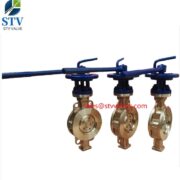API 609 Lug Type C95800 Butterfly Valve
1. Introduction to the API 609 Lug Type C95800 Butterfly Valve
2. Importance of understanding the valve for professionals
3. Technical specifications and unique features
4. Step-by-step guide on selecting and installing the valve
5. Maintenance and troubleshooting tips for optimal performance
6. Expert advice on integrating the valve into industrial applications
7. Conclusion: Leveraging the API 609 Lug Type C95800 Butterfly Valve for enhanced professional outcomes.
1. Introduction to the API 609 Lug Type C95800 Butterfly Valve
The API 609 Lug Type C95800 Butterfly Valve is a critical component in many industrial applications, providing reliable and precise control over the flow of fluids and gases. This comprehensive guide is designed to provide professionals with a detailed understanding of this valve and its various features. From its construction and materials to its operation and maintenance, every aspect of the C95800 butterfly valve will be explored in-depth. Whether you are a mechanical engineer, a plant manager, or a valve technician, this guide will equip you with the knowledge and expertise needed to effectively utilize and troubleshoot this valve.
2. Importance of understanding the valve for professionals
Having a comprehensive understanding of the API 609 Lug Type C95800 Butterfly Valve is of utmost importance for professionals in various industries. This valve plays a crucial role in controlling the flow of fluids and gases, ensuring the smooth operation of industrial applications.
For mechanical engineers, having a deep knowledge of this valve allows for accurate sizing and selection, ensuring that it meets the specific requirements of the system. Plant managers can benefit from understanding the valve’s construction and materials, enabling them to make informed decisions when it comes to maintenance and replacement.
Valve technicians can troubleshoot issues more effectively when they possess a thorough understanding of the valve’s operation and maintenance. This can minimize downtime and improve the overall efficiency of the system.
In summary, professionals who invest the time to understand the API 609 Lug Type C95800 Butterfly Valve gain a competitive advantage in terms of system performance, maintenance, and trouble-shooting capabilities.
3. Technical specifications and unique features
Understanding the technical specifications and unique features of the API 609 Lug Type C95800 Butterfly Valve is essential for professionals in various industries. This valve is designed to meet the specific demands of different applications, and its characteristics make it a reliable choice for controlling the flow of fluids and gases.
One key feature of this valve is its C95800 alloy construction. This material offers excellent corrosion resistance and high strength, making it suitable for a wide range of industrial environments. Additionally, the lug design allows for easy installation and maintenance, reducing both time and costs.
The API 609 standard ensures that the valve meets industry regulations and standards, ensuring its reliability and performance. The valve also offers a tight shut-off capability, preventing leakage and optimizing system efficiency.
By familiarizing themselves with the technical specifications and unique features of the API 609 Lug Type C95800 Butterfly Valve, professionals can make informed decisions when it comes to system design, maintenance, and replacement. This knowledge ultimately contributes to the overall success of their projects and operations.
4. Step-by-step guide on selecting and installing the valve
Selecting and installing the API 609 Lug Type C95800 Butterfly Valve requires careful consideration and attention to detail. Follow these steps to ensure a smooth and successful process:
1. Identify your application requirements: Understand the specific needs of your project, such as pressure rating, temperature range, and fluid compatibility. This will help you choose the appropriate valve size and design.
2. Consult with experts: Reach out to valve manufacturers or industry professionals who have experience with the API 609 Lug Type C95800 Butterfly Valve. They can provide valuable insights and recommendations based on your application requirements.
3. Evaluate the available options: Consider factors such as the valve’s flow capacity, operating torque, and sealing capabilities. Compare different models and brands to find the one that best suits your needs.
4. Ensure proper installation: Follow the manufacturer’s guidelines for installation, including torque specifications and recommended sealing materials. Properly align the valve with the piping system and tighten all connections to avoid leakage.
Taking the time to carefully select and install the API 609 Lug Type C95800 Butterfly Valve will ensure its optimal performance and longevity. By following these steps, professionals can confidently incorporate this valve into their systems and enjoy its numerous benefits. Stay tuned for the next section, where we will discuss common maintenance and troubleshooting tips for the API 609 Lug Type C95800 Butterfly Valve.
5. Maintenance and troubleshooting tips for optimal performance
Next Section: Maintenance and Troubleshooting Tips for Optimal Performance
Once the API 609 Lug Type C95800 Butterfly Valve is installed, it is important to implement regular maintenance practices to ensure its optimal performance. Proper maintenance can help prevent issues and extend the lifespan of the valve. Here are some essential maintenance and troubleshooting tips:
1. Regular inspection: Inspect the valve periodically for any signs of wear, corrosion, or leaks. Look for external damages or deformities that may affect its functionality.
2. Lubrication: Apply lubrication to the valve’s moving parts according to the manufacturer’s recommendations. This will help reduce friction and ensure smooth operation.
3. Leakage detection: Monitor the valve for any signs of leakage, such as fluid seeping through the seals or valve body. If leakage is detected, promptly address the issue to prevent further damage.
4. Cleaning: Clean the valve regularly to remove any debris or contaminants that may affect its performance. Use appropriate cleaning agents and methods recommended by the manufacturer.
5. Troubleshooting: In case of any operational issues or malfunctions, refer to the manufacturer’s troubleshooting guide. Follow the recommended steps to identify and resolve the problem efficiently.
By implementing these maintenance and troubleshooting tips, professionals can ensure that the API 609 Lug Type C95800 Butterfly Valve operates smoothly and efficiently throughout its lifespan. Stay tuned for the next section, where we will discuss additional features and considerations when working with this valve.
6. Expert advice on integrating the valve into industrial applications
In addition to regular maintenance, it is crucial to understand how to integrate the API 609 Lug Type C95800 Butterfly Valve into various industrial applications. Proper integration ensures optimal performance and compatibility with existing systems. Here are some expert tips:
1. Understand the application requirements: Before integrating the valve, thoroughly assess the specific needs of the application, such as flow rates, pressure ratings, and temperature ranges. This will help you choose the right valve size and specifications.
2. Consider the valve’s material compatibility: Make sure the valve is made from a material that is compatible with the fluid or gas passing through the system. Consider factors such as corrosion resistance, temperature tolerance, and chemical compatibility.
3. Consult with industry experts: If you are unsure about the integration process or have unique application requirements, it is beneficial to consult with industry experts. They can provide valuable insights and recommendations based on their experience.
4. Test and validate the integration: Before fully implementing the valve, conduct thorough testing and validation to ensure it operates as intended. This includes checking for leaks, verifying proper flow control, and assessing overall system performance.
By following these expert tips, professionals can successfully integrate the API 609 Lug Type C95800 Butterfly Valve into industrial applications, ensuring seamless operation and maximum efficiency. In the next section, we will explore some real-world examples of how this valve is utilized in different industries. Stay tuned!
7. Conclusion: Leveraging the API 609 Lug Type C95800 Butterfly Valve for enhanced professional outcomes
Next section:
The API 609 Lug Type C95800 Butterfly Valve is a versatile and reliable valve that can greatly improve the efficiency and performance of industrial applications. By properly integrating this valve into your systems, you can achieve enhanced professional outcomes.
Throughout this comprehensive guide, we have explored the importance of understanding application requirements and material compatibility. We have also highlighted the value of seeking advice from industry experts and conducting thorough testing and validation. By following these expert tips, professionals can confidently integrate the API 609 Lug Type C95800 Butterfly Valve, ensuring seamless operation and maximum efficiency.
In the next section, we will dive deeper into real-world examples of how this valve is utilized in different industries. This will provide you with practical insights and inspiration for incorporating the API 609 Lug Type C95800 Butterfly Valve into your own applications. Stay tuned!



